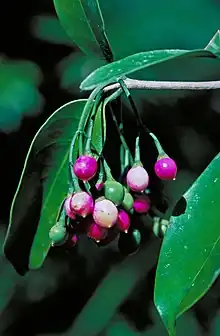| Yellowheart | |
|---|---|
 | |
| Fruit and foliage | |
| Scientific classification | |
| Kingdom: | Plantae |
| Clade: | Tracheophytes |
| Clade: | Angiosperms |
| Clade: | Eudicots |
| Clade: | Asterids |
| Order: | Gentianales |
| Family: | Gentianaceae |
| Genus: | Fagraea |
| Species: | F. fagraeacea |
| Binomial name | |
| Fagraea fagraeacea | |
| Synonyms[3] | |
Fagraea fagraeacea, commonly known as yellowheart, is a plant in the family Gentianaceae which is native to New Guinea and Queensland.[3][4] It was originally described in 1868 by the Victorian government botanist Ferdinand von Mueller as Gardneria fagraeacea, and published in his massive work Fragmenta phytographiæ Australiæ. The species was reviewed by George Claridge Druce in 1916 and given the new combination Fagraea fagraeacea, which was published in the Botanical Society and Exchange Club of the British Isles .[5]
Conservation
This species is listed by the Queensland Department of Environment and Science as least concern.[1] As of 8 May 2023, it has not been assessed by the International Union for Conservation of Nature (IUCN).
References
- 1 2 "Species profile—Fagraea fagraeacea". Queensland Department of Environment and Science. Queensland Government. 2022. Retrieved 8 May 2023.
- ↑ "Fagraea fagraeacea". Australian Plant Name Index (APNI). Centre for Australian National Biodiversity Research, Australian Government. Retrieved 8 May 2023.
- 1 2 3 "Fagraea fagraeacea (F.Muell.) Druce". Plants of the World Online. Royal Botanic Gardens, Kew. Retrieved 8 May 2023.
- ↑ F.A.Zich; B.P.M.Hyland; T.Whiffen; R.A.Kerrigan (2020). "Fagraea fagraeacea". Australian Tropical Rainforest Plants Edition 8 (RFK8). Centre for Australian National Biodiversity Research (CANBR), Australian Government. Retrieved 8 May 2023.
- ↑ Druce, G.C. (1917). "Nomenclatorial Notes: chiefly African and Australian". Botanical Exchange Club of the British Isles. 4: 623. Retrieved 8 May 2023.
External links
 Data related to Fagraea fagraeacea at Wikispecies
Data related to Fagraea fagraeacea at Wikispecies Media related to Fagraea fagraeacea at Wikimedia Commons
Media related to Fagraea fagraeacea at Wikimedia Commons- View a map of historical sightings of this species at the Australasian Virtual Herbarium
- View images of this species on Flickriver
This article is issued from Wikipedia. The text is licensed under Creative Commons - Attribution - Sharealike. Additional terms may apply for the media files.